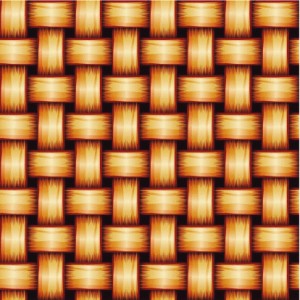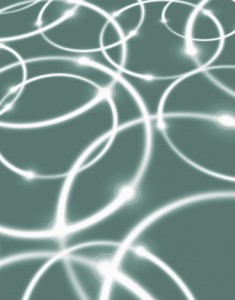Relationship Differences: Fusion and De/fusion (Part 6)
By Asher Crispe: January 1, 2013: Category Inspirations, Quilt of Translations
 We live within worlds and worlds live within us. Each world in our four-tiered system manifests as a different type of consciousness. These types of consciousness unfold as powers of the soul which themselves ‘spell out’ the Divine name–the Tetragrammaton–which is inscribed within everything in existence. In formulaic notation: Four Worlds = Four Letters of the Divine name = Four nodes of the powers of the soul. Each set comments on the others. By braiding them all together we can glean even more insight into our relationship possibilities of being lonely, adversarial, supportive and devoted.
We live within worlds and worlds live within us. Each world in our four-tiered system manifests as a different type of consciousness. These types of consciousness unfold as powers of the soul which themselves ‘spell out’ the Divine name–the Tetragrammaton–which is inscribed within everything in existence. In formulaic notation: Four Worlds = Four Letters of the Divine name = Four nodes of the powers of the soul. Each set comments on the others. By braiding them all together we can glean even more insight into our relationship possibilities of being lonely, adversarial, supportive and devoted.
Beginning once again with the most advantageous, the relationship of selfless dedication (to be ‘to’ or ‘for’ the other) links up with the world of Emanation. In terms of our relationship with the Divine Other, residing in this world would be the equivalent of total self-sacrifice in order to be close (atzel or emanation in Hebrew connotes such closeness) to the Divine. A person might seek a situation whereby nothing comes in between oneself and one’s Creator–especially one’s own egotistical desire and self-interests. ‘I want to return to my source.’ Cleaving with Divinity, I cannot explain the relationship bond in purely rational terms. In essence, my commitment transcends rationality. It endures as an unconditional timeless bond. In the soul, this capacity is called chochmah which translates as ‘wisdom’ or ‘intuition.’
My intuition is the specific faculty that imports new insight into my mind but is not limited to the restricting thinking native within my mind. Upon inspection (or introspection) we find that our experience of a blast of insight comes to us from the ‘outside’ as an intuitional leap. ‘Leaping’ signifies a disjunctivism or discontinuity within the conventional flow of thought. We spring to another plane which is above and beyond our ordinary cognitive capacity. As such, we might think of chochmah (intuition) as the impulse to ‘give myself over’ that arises from within myself. It literally acts ‘meta-cognitively.’ I am ‘out of my mind’ so to speak for the sake of sharing in something which is greater than me–something ‘other,’ something that I will never understand on my own.
In order to merit an influx of wisdom, one needs to reach a place where the ego can be shed–a temporary forgetting of my self as an independent self. Vaulting over all of the perceived dualism, I allow myself to become one with that which is other than me in a form of psycho-synthesis. The tzadikkim or ‘righteous’ in every generation live perpetually in this state of unity. According to the mystical tradition, one of the most commonly referenced opinions contends that there are 36 such individuals alive at all times. One of the hidden implications of this number is that 36 equals ‘lo’ [לו] or ‘to/for him’. If we are to address the human other, then ‘him’ is with a lower case ‘h.’ But this verse can also speak to our relationship with a Divine Other in which case it should be read as ‘to/for Him’ (the Creator).
Since we keep dancing around the issue, it makes sense to address the gender construction of this verse. Why is the ‘dedication’ addressed to the masculine? When we entertain notions of gender in the creature/Creator relationship we crack open the underlying significance ever so slightly. For instance, in the Song of Songs, the well-known metaphor places Israel in the role of being the bride while God becomes the groom. All of creation is really just the feminine side of Divinity. Without even pursuing the substantial commentary tradition on this metaphoric arrangement, we might guess that the transcendent aspect of Divinity is rendered masculine in so much as He is a Creator. All our lives and life energy is deposited within us. We are impregnated with it. Our task is to gestate with this Divinely inspired vitality and to develop it according to the best of our ability.
From here we can segue into the full blown kabbalistic view of gender theory. The crux of the idea is that biological sex and gender diverge in significant ways. Gender is not reducible to biology, nor the other way around. Nonetheless, there is a certain play that goes on in all Torah-based texts whereby the masculine mode of being borrows from the biological reproductive process and abstracts it. To be in this mode amounts to being a transmitter or a giver. Likewise, a similar tactic is adopted with the feminine mode of being. To be in the feminine mode implies that one is being receptive. Obviously, both men and women have both modalities (often at the same time). We are ultimately gender dimorphic (we find evidence of this in the first account of the creation of the man and woman in Genesis 1:27 “…male and female, He created them” is midrashically taken to mean what the primacy of the human condition is to be androgynous). As we find in the Talmud (Yevamot 62b): “R. Tanhum stated in the name of R. Hanilai: Any man who does not have a wife lives without joy, without blessing, and without goodness.”
Using this explanation to reframe our discussion about being ‘to’ or ‘for’ Him/him, we can surmise that we all receive our lives, our existence, our talents and abilities from the Creator. We are therefore maximally feminine in this respect relative to the Creator. If we extend this to the realm of the interpersonal, then both spouses get to play both roles. I should look upon my wife as the source of all that I have. When I think of her in this light, I am transferring myself into the feminine mode of being while shifting her into the masculine mode of being.
In more neutered language, this means that I should regard my significant other (and indeed by extension all others) as the greatest source of blessing. I appreciate you for all that you have bestowed upon me, or to state the converse, I recognize how much I have received from you. No matter who I am in the relationship, I regard the other/Other as giver and myself as receiver. In the interpersonal realm, ideally we both should think we received more than we could have possibly given resulting in the posture of being “lo” (to/for the other).
 Yet when it comes to our marriage to the Divine, we are always on the feminine side of the equation. Or are we? One of the deepest insights relayed in the Zohar is the idea that we can ‘benefit’ and ‘give’ back to the Creator. While this is somewhat of a ruse and can only be considered ‘so to speak’ on account of there being nothing besides the Creator (henceforth all giving is really God giving to Himself), we continue to reflect on this language specifically when it comes to the performance of mitzvot (commandments). Prayer, in particular, would be one of the strongest examples of our being licensed to ‘create’ God’s will as it were. (However, this doesn’t escape the circularity of it being His highest will that we should create His will in a more basic way.) The point being that we flirt with these kinds of gendered language games in order to pursue mystical understanding.
Yet when it comes to our marriage to the Divine, we are always on the feminine side of the equation. Or are we? One of the deepest insights relayed in the Zohar is the idea that we can ‘benefit’ and ‘give’ back to the Creator. While this is somewhat of a ruse and can only be considered ‘so to speak’ on account of there being nothing besides the Creator (henceforth all giving is really God giving to Himself), we continue to reflect on this language specifically when it comes to the performance of mitzvot (commandments). Prayer, in particular, would be one of the strongest examples of our being licensed to ‘create’ God’s will as it were. (However, this doesn’t escape the circularity of it being His highest will that we should create His will in a more basic way.) The point being that we flirt with these kinds of gendered language games in order to pursue mystical understanding.
What we can take away from all this is that within the context of this highest world, I attain insight and intuition into the Other/other by virtue of transcending my ego and opening myself with selfless dedication to the Other/other. At this level, intuition allows for the weakening of the self-other distinction while not entirely effacing it. Consequently, the unity that results could best be described as the unity of two or the biunal condition of reality.
For Part Seven, our attention turns to the three lower worlds of Creation, Formation and Action and the soul powers and relationships reflected therein.
http://www.interinclusion.org/inspirations/relationship-differences-fusion-and-defusion-part-7/
http://www.interinclusion.org/inspirations/relationship-differences-fusion-and-defusion-part-5/














;)
;)
;)
;)
;)
;)
;)
;)
;)
;)
